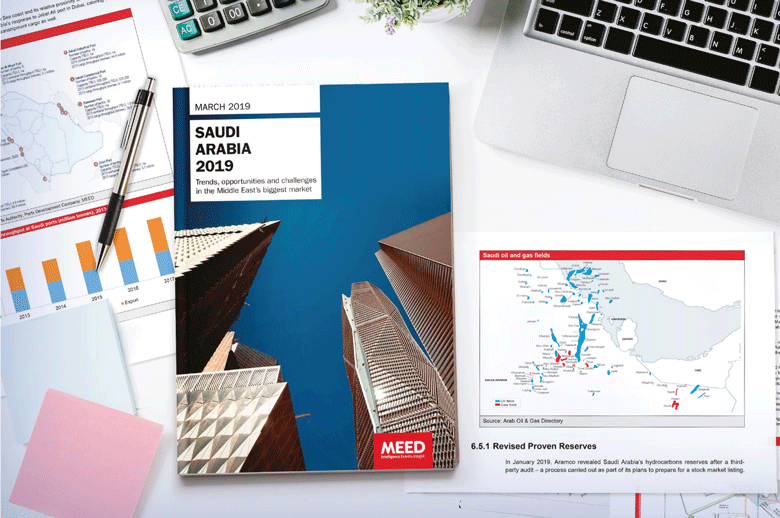

With more than $1.4 trillion-worth of major projects planned or underway, Saudi Arabia is the biggest projects market in the region. Nearly double the size of the next-largest market, the UAE, Saudi Arabia is home to almost half of all projects planned in the GCC.
At the same time, the kingdom’s rapidly growing population of more than 32 million people is driving surging demand for all kinds of goods and services, ranging from consumer products to electricity, healthcare services and infrastructure. Anyone who is serious about doing business in or with the Middle East must make the time to understand and connect with Saudi Arabia. And now is the right time to do so.
Economic recovery
The high-profile launch in October 2017 of the $500bn Neom City project marked the start of a new era for the giant Saudi economy. It is a future that promises investment and business opportunities across all sectors, but one that will also involve significant changes to the Saudi market.
After some extremely challenging years following the crash in oil prices in June 2014, the launch of Neom and several other megaprojects, including the Red Sea project and Al-Qiddiya Entertainment City, in the second half of 2017 signalled the return to a more positive outlook. Being delivered by the Public Investment Fund (PIF) – which over recent years has become the major driver of capital investments in Saudi Arabia – the new projects will give the kingdom’s economic recovery some much-needed momentum.
The megaprojects are the cornerstone of Saudi Arabia’s ambitious Vision 2030 economic transformation programme, which was launched in April 2016 to provide a roadmap for the diversification of the Saudi economy. Vision 2030 aims to attract private investment into the kingdom’s infrastructure, housing, transport, healthcare, and power and water sectors. As part of that, Riyadh is changing the way in which projects are procured, with a new push for public-private partnerships (PPPs).
It is also aiming to diversify the economy away from oil and create new jobs by encouraging new high-tech industries and privatising state companies and assets.
 MEED’s biggest annual report, Saudi Arabia 2019: Trends, opportunities and challenges in the Middle East’s biggest market, is a powerful resource for anyone seeking to identify opportunities, understand risks and set strategy in Saudi Arabia
MEED’s biggest annual report, Saudi Arabia 2019: Trends, opportunities and challenges in the Middle East’s biggest market, is a powerful resource for anyone seeking to identify opportunities, understand risks and set strategy in Saudi Arabia
Project spending
Few markets were as hard hit by the 2014 downturn in oil prices as Saudi Arabia, but there has been a clear turnaround since then. While project activity improved slightly in 2017, the trend did not continue in 2018 due to cutbacks in government spending and many projects were either put on hold or cancelled. The overall value of contracts awards in 2018 was just $21.3bn – low compared to the annual average of $40.6bn since 2010 and the peak of $58.3bn in 2013.
However, the value of projects in the pre-execution phases is now more than double that of projects under execution, which bodes well for the future.
Furthermore, the government is planning to invest heavily in developing the kingdom’s infrastructure in the coming years. In one indicator of this, in 2019 the government increased the transport and infrastructure development budget to $18.6bn.
In terms of the number of projects, the transport sector has the most extensive pipeline, with about $253bn-worth of projects in the tender, design or study phase.
Meanwhile, national oil company Saudi Aramco is focusing on the development of its downstream refining and petrochemicals activities. In the past five years, Aramco has awarded several multibillion-dollar contracts, including four contracts for the Jizan Refinery IGCC power plant. Currently, Aramco’s total contracts under execution amount to $69.4bn.
While the value of contract awards in the hydrocarbons sector was under $5bn in 2018, more than $63bn-worth of projects are expected to be awarded between 2019 and 2021.
 |
Faced with a shortage of readily available gas supplies and attracted by the falling cost of renewable energy technology, the kingdom is also procuring or planning a series of solar and wind power projects. New targets have been set this year, with Saudi Arabia now aiming to develop 27.3GW of renewable generating capacity by 2024 and 58.7GW by 2030.
GDP growth in the kingdom was 2.2 per cent in 2018, following a decline of 0.9 per cent in 2017. According to the government’s 2019 budget statement, GDP growth is expected to reach 2.6 per cent in 2019, with the oil sector likely to outpace the non-oil sector. Overall economic expansion will be supported by sustained government spending of SR1.1tn over the year.
Access the reportSaudi Arabia 2019: Trends, opportunities and challenges in the Middle East’s biggest market is the latest premium market intelligence report from MEED. It provides a comprehensive and up-to-date guide for companies seeking to work in or with Saudi Arabia, highlighting new opportunities as well as identifying potential challenges. Covering the core sectors of the economy including oil and gas, petrochemicals, power, construction, water, wastewater, manufacturing and transport, Saudi Arabia 2019: Trends, opportunities and challenges in the Middle East’s biggest market details the projects planned and under way. Buy the report here |
You might also like...

Iraq signs deal to develop the Akkas gas field
25 April 2024

Emaar appoints beachfront project contractor
25 April 2024

Acwa Power signs $356m Barka extension
25 April 2024

AD Ports secures Angola port concession agreement
25 April 2024
A MEED Subscription...
Subscribe or upgrade your current MEED.com package to support your strategic planning with the MENA region’s best source of business information. Proceed to our online shop below to find out more about the features in each package.




